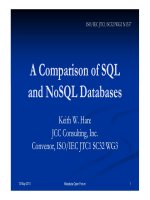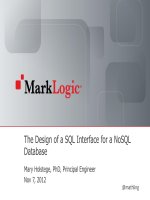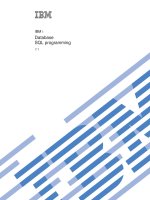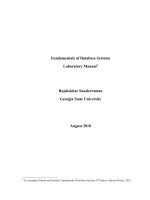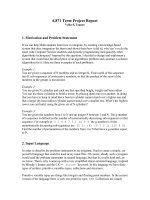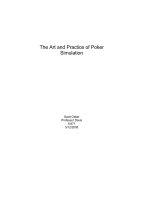TÀI LIỆU - Cao Học Khóa 8 - ĐH CNTT 5. a NoSql
Bạn đang xem bản rút gọn của tài liệu. Xem và tải ngay bản đầy đủ của tài liệu tại đây (1.83 MB, 94 trang )
April 26, 2012
NoSQL Databases – Amir H. Payberah
1
Not Only SQL (NoSQL)
Databases
Amir H. Payberah
April 26, 2012
NoSQL Databases – Amir H. Payberah
2
SQL is Good
●
●
●
Relational Databases Management Systems (RDMBSs) – mainstay of
business
SQL is good
Rich language
Easy to use and integrate
Rich toolset
Many vendors
They promise: ACID
April 26, 2012
NoSQL Databases – Amir H. Payberah
3
ACID Properties
●
●
●
●
Atomicity: all included statements in a transaction are either executed or
the whole transaction is aborted without affecting the database.
Consistency: a database is in a consistent state before and after a
transaction.
Isolation: transactions can not see uncommitted changes in the database.
Durability: changes are written to a disk before a database commits a
transaction so that committed data cannot be lost through a power failure.
April 26, 2012
NoSQL Databases – Amir H. Payberah
4
SQL is Good
●
SQL is good, ...
April 26, 2012
NoSQL Databases – Amir H. Payberah
5
April 26, 2012
NoSQL Databases – Amir H. Payberah
6
SQL Challenges
●
Webbased applications caused spikes.
Internetscale data size
High readwrite rates
Frequent schema changes
Large data
April 26, 2012
NoSQL Databases – Amir H. Payberah
7
The Past and the Moment
/>
April 26, 2012
NoSQL Databases – Amir H. Payberah
8
Let's Scale RDBMSs
●
RDBMS were not designed to be distributed.
●
Possible solutions:
Replication
Sharding
April 26, 2012
NoSQL Databases – Amir H. Payberah
9
Let's Scale RDBMSs Replication
●
●
Master/Slave architecture
It scales read operations
Master Server
Slave Server1
April 26, 2012
Slave Server2
NoSQL Databases – Amir H. Payberah
10
Let's Scale RDBMSs Sharding
●
●
Scaling out (horizontal scaling) based on data partitioning, i.e. dividing
the database across many (inexpensive) machines.
This is how youtube, facebook,
yahoo all started. With sharded mysql.
●
It scales read and write operations,
but you can't execute transactions
across shards (partitions).
April 26, 2012
NoSQL Databases – Amir H. Payberah
11
Scaling RDBMSs is Expensive and Inefficient
[ />
April 26, 2012
NoSQL Databases – Amir H. Payberah
12
Not Only SQL
April 26, 2012
NoSQL Databases – Amir H. Payberah
13
What is NoSQL?
●
Class of nonrelational data storage systems.
●
All NoSQL offerings relax one or more of the ACID properties.
April 26, 2012
Social applications are not banks and they don't need the same level of ACID.
NoSQL Databases – Amir H. Payberah
14
NoSQL History
●
●
●
It was first used in 1998 by Carlo Strozzi to name his relational
database that did not expose the standard SQL interface.
The term was picked up again in 2009 when a Last.fm develper, Johan
Oskarsson, wanted to organize an event to discuss opensource
distributed databases.
The name attempted to label the emergence of a growing number of
nonrelational, distributed data stores that often did not attempt to
provide ACID.
April 26, 2012
NoSQL Databases – Amir H. Payberah
15
Categories of NoSQL Databases
●
Key/Value stores
●
Columnoriented databases
●
Dynamo, Scalaris, Berkeley DB, ...
BigTable, Hbase, Cassandra, ...
Document databases
April 26, 2012
MongoDB, Terrastore, SimpleDB, ...
NoSQL Databases – Amir H. Payberah
16
NoSQL Cost
[ />
April 26, 2012
NoSQL Databases – Amir H. Payberah
17
SQL vs. NoSQL
[ />
April 26, 2012
NoSQL Databases – Amir H. Payberah
18
Consistency
●
Strong consistency
April 26, 2012
Single storage image. Informally, after an update completes, any subsequent
access will return the updated value.
NoSQL Databases – Amir H. Payberah
19
Consistency
●
Strong consistency
●
Single storage image. Informally, after an update completes, any subsequent
access will return the updated value.
Eventual consistency
April 26, 2012
The system does not guarantee that subsequent accesses will return the updated
value.
Inconsistency window.
If no new updates are made to the object, eventually all accesses will return the
last updated value.
NoSQL Databases – Amir H. Payberah
20
Quorum Model
●
N: the number of nodes to which a data item is replicated.
●
R: the number of nodes a value has to be read from to be accepted.
●
W: the number of nodes a new value has to be written to before the write operation is
finished.
●
To enforce strong consistency: R + W > N
April 26, 2012
NoSQL Databases – Amir H. Payberah
21
Quorum Model
●
N: the number of nodes to which a data item is replicated.
●
R: the number of nodes a value has to be read from to be accepted.
●
W: the number of nodes a new value has to be written to before the write operation is
finished.
●
To enforce strong consistency: R + W > N
R = 3, W = 3, N = 5
April 26, 2012
R = 4, W = 2, N = 5
NoSQL Databases – Amir H. Payberah
22
Relaxing ACID Properties
●
The largescale applications have to be reliable: availability + redundancy
●
These properties are difficult to achieve with ACID properties.
●
The BASE approach forfeits the ACID properties of consistency and isolation in favour
of availability, graceful degradation, and performance.
April 26, 2012
NoSQL Databases – Amir H. Payberah
23
BASE Properties
●
Basically Available: possibilities of faults but not a fault of the whole system.
●
Soft state: copies of a data item may be inconsistent.
●
Eventually consistent: copies becomes consistent at some later time if there are no
more updates to that data item.
April 26, 2012
NoSQL Databases – Amir H. Payberah
24
CAP Theorem
●
●
●
Consistency: how a a system is in a consistent state after the execution of an
operation.
Availability: clients can always read and write data in a specific period of time.
Partition Tolerance: the ability of the system to continue operation in the
presence of network partitions.
You can choose only two!
April 26, 2012
NoSQL Databases – Amir H. Payberah
25


